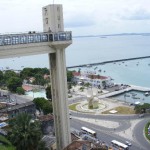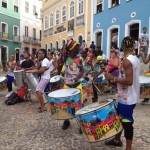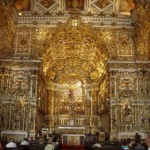[gn_spoiler title=”Praia do Forte” open=”0″ style=”2″]
Located 82 km north of Salvador, the Praia do Forte was named the “Brazilian Polynesia”. Despite of being tourist-oriented, it is probably one of the most beautiful and pleasant beaches in the Northeast, and a good way to relax away from the noise and crowds of Salvador.
[/gn_spoiler] [gn_spoiler title=”Pelourinho” open=”0″ style=”2″]During the time of slavery, this was the place slaves were punished. Several old houses and mansions in the purest colonial style surround the square.
The Pelourinho is a must-see when visiting Salvador; the site brings together restaurants with the best flavor of Bahian cuisine, crafts, baroque architecture, religion, cultural centers and legitimate Olodum drumming.
Tuesdays are reserved for shows such as the Olodum band, which attracts thousands of people to the streets and squares of Pelourinho.
Former Brazilian Institute of Forest Development-IBDF, which later became the IBAMA, created the Tamar Project in 1980 the Brazilian Institute of the Environment. Today, it is recognized internationally as one of the most successful experiences of marine conservation and serves as a model for other countries, especially because it involves coastal communities directly in socio-environmental work.
Located in Praia do Forte 70 kilometers from Salvador, the Tamar project is engaged in the research, conservation and management of five endangered sea turtle species. In the spawning season, between September and March, the foundation monitors 30km of beaches, between the rivers of Jacuípe and Imbassaí, protecting more than 1,600 nests annually and 100,000 chicks. The entire length of Praia do Forte (14 km) is considered Integral Study Area (SRA).
- Phone (71) 3676-1045 – Fax (71) 3676-1067
- E-mail: protamar@tamar.org. br
The most unique way to move between the Upper Town and Lower Town is via the Lacerda Elevator, one of the landmarks of Salvador opened in 1872. At 72 meters high, it links the Square Tomé de Souza (upper town) and Square Cairu (lower town).
Restored in 2002, it gained new night-light and panoramic windows that unveil the pier and the market. There are four cabins the 1 and 2 are original, used since the inauguration. The number 3 and 4 were reformed in 1930. A trip last about 30 seconds and carries an average of 20,000 people per day.
City High – Square Tomé de Souza, s / n
Lower City – Plaza Viscount of Cairo, s / n
Phone: (71) 3243-4030 / (71) 3322-7049
The FOLKLORIC BALLET OF BAHIA (BFB), the only professional folk dance company in the country, was created in 1988 by Walson Botelho and Nest Kings and has since been a significant curriculum activity and a considerable prestige reflected in the response of audiences and critics.
With a schedule planned ahead for many years with international tours, the BFB has a second company that performs daily shows, since 1995, at the Teatro Miguel Santana (company headquarters), in Pelourinho, serving foreign and national tourists.
Teatro Miguel Santana
- Adress: Rua Gregório de Matos, 49 – Pelourinho
- Phonel/Fax: 55 (71) 3322-1962
- E-mail: w.botelho@terra.com.br
[/gn_spoiler] [gn_spoiler title=”Sao Francisco Church” open=”0″ style=”2″]
The Church and Convent of San Francisco are important historic buildings in the city of Salvador.
Located in the heart of the city, the structures were built between the seventeenth and eighteenth centuries and are considered one of the most unique and rich expressions of Brazilian Baroque, featuring in particular a sumptuous interior of the church. It was listed by Iphan, classified as one of the Seven Wonders of Portuguese Origin, and is part of the Historic Centre of Salvador, a World Heritage Site.
[/gn_spoiler] [gn_spoiler title=”Senhor do Bonfin Church” open=”0″ style=”2″]The church Bom Jesus do Bonfim in Salvador, was built between 1746 and 1754 to house the image of Senhor Bom Jesus do Bonfim, brought from Lisbon in 1745. In 1927, Pope Pio XI elevated to the dignity of the temple to Basilica.
The architecture of the facades is neo-classical and Rococo. It follows the model of the Portuguese churches of 18th and 19th centuries, with beautiful frescoes and tiles.
[/gn_spoiler] [gn_spoiler title=”Praia de Itapoan” open=”0″ style=”2″]With its fishermen and their jangadas (little wood boat), Itapuã is a rocky beach, when the tide is low it becomes natural pools adorned by hundreds of towering coconut trees. It has a bohemia atmosphere, lighthouse, a mermaid statue and the best acarajé (regional dish). The neighborhood and its beaches were contemplated by song and national movies.
[/gn_spoiler] [gn_spoiler title=”Itaparica Island” open=”0″ style=”2″]Itaparica Island
The most famous island of Salvador, Itaparica is divided into two municipalities: Itaparica and Vera Cruz. In Tupi language Itaparica means, “stone fence”, because the island is surrounded by a barrier reef. Itaparica has vast tropical vegetation, a rich cultural and natural heritage, and a landscape enchanted by beauty and a rich history.
The 240km ² beaches offer options of diving, hiking, horseback riding, biking, kayaking adventures and large pools of calm water, ideal for relaxing, enjoying the sun and the breeze of the wind. If you are looking for adventure with a good dose of serenity, Itaparica Island is the ideal sought.
[/gn_spoiler] [gn_spoiler title=”Abaete Lake” open=”0″ style=”2″]Lagoon of mysteries and charm, many legends have sprung up around the dark waters of this mass of fresh water surrounded by huge dunes of sand. The old laggon, hidden amidst natural beauty, was revered as sacred by the followers of Candomblé (local religion).
Few inhabitants visit Abaete Lake, as all feared bathing in its waters and being “devoured” in mysterious whirlpools. A few drowning deaths only increased this aura of mystery.
[/gn_spoiler] [gn_spoiler title=”Mercado Modelo” open=”0″ style=”2″]Among the Lacerda Elevator and Church of Nossa Senhora da Conceição da Praia is one of the most visited tourist sites in the city of Salvador : the Mercado Modelo (Market). The Model Market sells handicrafts and other products typical of Bahia and like any tourist spot in Salvador, the market also has its curiosities, such as the discovery of underground tunnels of the building – used for storage of products. But the popular legends report that the site served to keep newcomer slaves. And there are those who say you can hear the noise of the chains of slaves.
Open to the public from Monday through Saturday from 9h to 19h. Sundays and holidays: from 9 am to 14 pm.
[/gn_spoiler] [gn_spoiler title=”Farol da Barra” open=”0″ style=”2″]Located at Barra beach, Farol da Barra was the first lighhouse of Brazil and the oldest of the Continent (1698).
In the seventeenth century, the port of Salvador was one of the busiest and most important of the continent, and had to assist vessels that arrived at the Bay of All Saints in search for the Brazilian wood, sugar, cotton, tobacco and other items to supply the European consumer market.
At the end of that century, after the tragic sinking of the ship Galleon Blessed Sacrament, the lighthouse of Santo Antonio da Barra was built, during the government of João de Lencastre (1694-1702), a square tower topped by a bronze lantern glass, powered by whale oil – according to the Institute Geography and History of Bahia.



